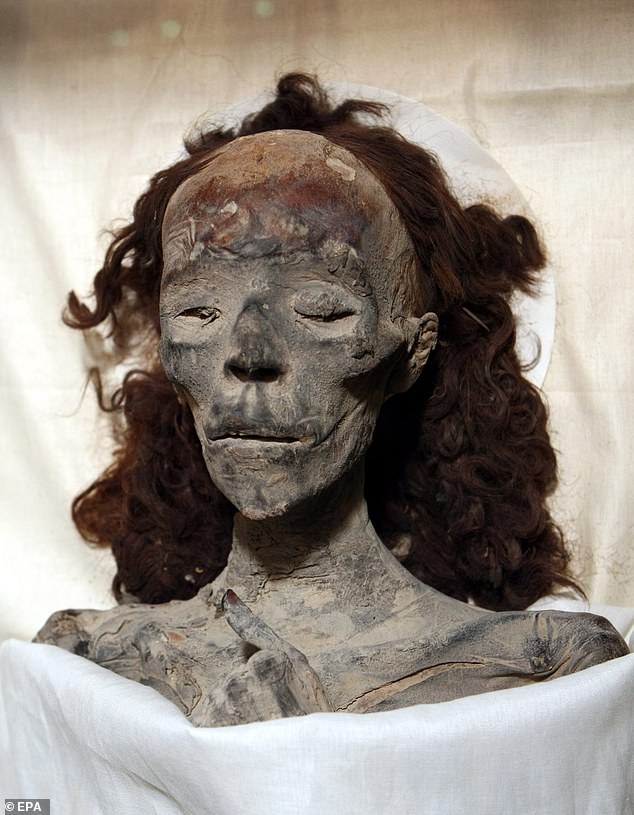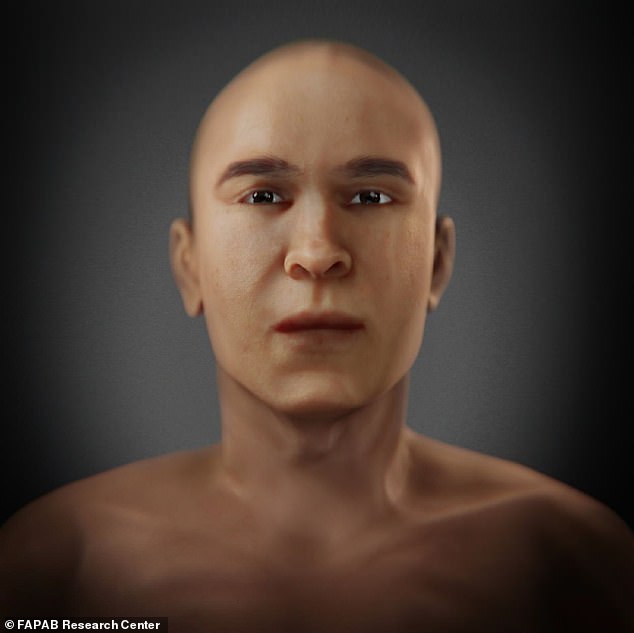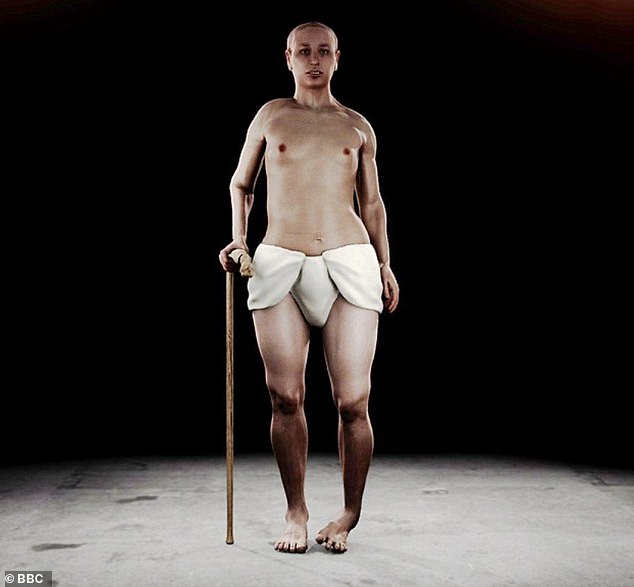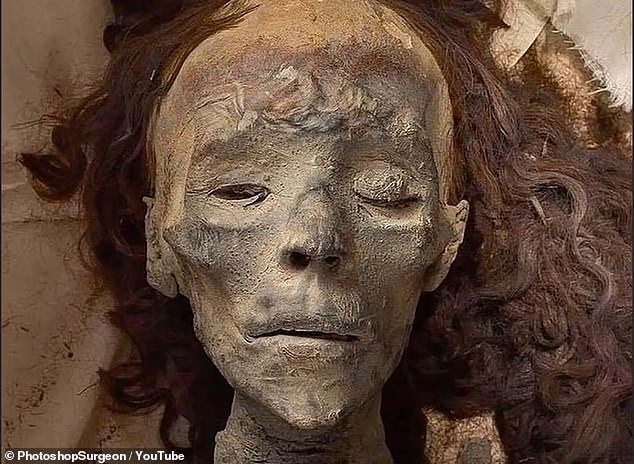A Photoshop artist has reconstructed the face of Queen Tiye, King Tut’s grandmother, using her 3,400-year-old mummified remains.
The artist used technology to superimpose features such as eyes, nose and mouth onto the image, fitting them into her remarkably preserved bone structure.
They then added hair, eyebrows, eyelashes and even freckles, bringing the corpse’s face to life.
The end result was a beautiful woman with dark flowing hair, big brown eyes, a heart-shaped mouth, and a dark complexion.
Queen Tiye was the great royal wife of the Egyptian pharaoh Amenhotep III, who reigned from 1390 to 53 BC. C. and lived from 1398 BC. C. until 1338 BC.
She was the mother of Amenhotep IV, also known as Akhenaten, and remained a prominent figure in Egyptian royalty even after he ascended the throne.
Akhenaten became the father of Tutankhamun, or King Tut, the boy king who ruled from 1332 to 1323 BC
He became pharaoh when he was only eight or nine years old, and today he is famous because his is the most intact Egyptian royal tomb ever found.
Queen Tiye’s mummy was discovered in 1898 in the tomb of Amenhotep II in the Valley of the Kings, but DNA analysis confirmed her identity only in 2010.
Photoshop surgeon used image of Queen Tiye’s mummified remains to reconstruct what she might have looked like
The Photoshop Surgeon, a digital artist who performs “dramatic enhancements and radical transformations on photographs,” revealed what the face of King Tut’s grandmother, Queen Tiye, may have looked like using an image of her remains.
The video shows the artist working with Photoshop, which shows an image of Queen Tiye’s mummified face.
They begin by placing his eyes in the sunken eye sockets, blending the skin around the eyelids, and then moved on to his nose, which was carefully added to fit the bone that was left.
The artist added long, curly brown hair that fit the hairline on her skull and filled in her brow bone with small strands of hair.
They also added more skin to Queen Tiye’s face, creating as plump an appearance as she may have ever appeared.
The artist also included her mummified hand that rested on her chest, but brought it back to life, showing wrinkles around the knuckles and nails on the tips of her fingers.
Queen Tiye was the daughter of Yuya, an Egyptian chariot commander, and an Egyptian woman named Thuya. She was of no royal blood, but despite this, her husband favored her among his many wives and often involved her in state affairs.
His name even appeared alongside the king’s in official documents.

The artist overlaid features such as eyes, nose and mouth, as well as hair, eyebrows and eyelashes to reveal the above result.

Queen Tiye’s mummy was discovered in 1898 in the tomb of Amenhotep II in the Valley of the Kings, but DNA analysis confirmed her identity only in 2010.
Queen Tiye’s remains were discovered in 1898 by French archaeologist Victor Loret, but it would be another century before experts realized who they belonged to.
Loret discovered two female mummies among several buried within the tomb of Amenhotep II in the Valley of the Kings, the burial place of almost all the pharaohs of the 18th, 19th and 20th dynasties.
Before being identified, these mummies were nicknamed “The Old Lady” and “The Young Lady.”
Initially, experts believed that ‘The Eldest Lady’ could have been Queen Nefertiti, who ruled during the 18th Dynasty as the Great Royal Wife of Pharaoh Akhenaten, son of Queen Tiye.
But a lock of hair found in a small coffin with an inscription naming Queen Tiye turned out to be an almost perfect match with ‘The Eldest Lady’s’ hair.
And in 2010, a DNA analysis confirmed that the remains belonged to the daughter of Yuya and Thuya, Queen Tiye’s parents.
Queen Tiye died sometime between the ages of 40 and 60.
Scientists have also reconstructed the faces of King Tut and his father, Pharaoh Akhenaten, showing that they had similar features.
Scientists used a skull discovered in the Valley of the Kings almost 100 years ago to reconstruct the appearance of Pharaoh Akhenaten, who ruled from 1353 BC to 1335 BC
The digital image shows a man in his 20s with a long jaw and piercing eyes, along with a skull-like shape and a pointed nose that resembles that of King Tut.

She was the mother of Amenhotep IV, also known as Akhenaten, and remained a prominent figure in Egyptian royalty even after he ascended the throne. The photo shows a facial reconstruction of Akhenaten.

Akhenaten became the father of Tutankhamun, or King Tut, the boy king who ruled from 1332 to 1323 BC Pictured is a reconstruction of what King Tut may have looked like.
The digital image of Akhenaten was created by the Research Center for Forensic Anthropology, Paleopathology and Bioarchaeology (FAPAB) in Sicily, which used a skull from a mummy discovered in 1907.
Akhenaten married one of his sisters, who gave birth to their son, but as a result of the incestuous relationship, Tutankhamun was born with numerous health problems that, according to experts, caused his premature death.
And a reconstruction of his face and body showed the world an idea of the ailments he may have suffered.
King Tut had buck teeth, club feet and girlish hips, according to the most detailed examination ever conducted of the ancient Egyptian pharaoh’s remains.
And rather than being a boy king who loved chariot racing, Tut relied on canes to get around during his rule in the 14th century BC. C., the researchers said.
A “virtual autopsy”, made up of more than 2,000 computer scans, was carried out, along with genetic analysis of Tut’s family, supporting evidence that his parents were brother and sister.
Scientists believe this left him with physical disabilities caused by hormonal imbalances. And his family history could also have led to his untimely death in his late teens.

